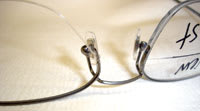feature
Chipping Away
In this OLA-sponsored article, lab experts
examine the impact of chipped and cracked lenses and what ECPs can do to prevent
future mishaps
By
Alex Yoho, ABOM

How have chipped or cracked lenses affected your lab?
Granby: It creates a perception of poor workmanship, especially by inexperienced dispensers.
Goh: Increased delays, turn time, and spoilage all increase our cost and man hours. They also slow down other jobs.
Vitale: With the increase in rimless frames, chipped and cracked lenses have increased the number of spoilages, both internally and in returns from the ECP.
|
|
|
Cracked lenses hold up the work flow in a lab |
Conway: Chipped or cracked lenses contribute to lost revenue, dissatisfied customers, and lab inefficiency.
Szymanski: Obviously anything that increases breakage negatively affects our laboratory. Both time and money are wasted. More importantly, this kind of breakage affects our ability to service our customers. Last and surely not least, is the negative effect on revenue.
How do chipped or cracked lenses affect your accounts?
Granby: They cause delays to patients who voice their displeasure to the office staff and doctor.

Bowers: This causes delays in delivery and increases warranty work.
What steps has your lab taken to address lenses and frames that seem to be problematic?
Granby: We screen rimless and drilled frames and will then recommend the correct material that will not chip or break after dispensing.
Conway: We call the accounts and remind them that using
the correct material (i.e., poly, Trivex, high-index) will virtually eliminate breakage.

Wallof: We call accounts and routinely offer alternative solutions, such as Phoenix (Trivex).
Bowers: We do not warranty certain materials for certain mountings that we know to be problematic. Frames are the bigger issue, as most are sold to the patient prior to the lab seeing the frame and in many cases we have already started the manufacturing process.
Szymanski: We have built a frame shape database, which helps us isolate and identify problematic areas. We closely monitor C sizes and drilling irregularities. We measure and monitor depths of grooves and accumulate manufacturers' information.
|
|
|
There are a variety of factors contributing to cracking and chipping, including lens material or frame selections that do not take potential damage into consideration |
Are there methods your accounts can use to avoid chipping or cracking lenses when they take on some of the manufacturing process?
Granby: Processing shortcuts are not recommended. The best remedy is the correct material for the frame design. Interliners and cushions are shortcuts.
Goh: Give a slightly heavier safety bevel and use Trivex or poly material. Mount string from the front side of lens toward the back side of a lens, from temple to nasal.
Vitale: Use the proper tools and techniques when adjusting a pair of glasses. Take the time to properly secure the mounting points prior to adjusting. For our uncut customers: Use sharp drill bits and chamfering the drill holes prior to mounting the lenses.
| COMMUNICATION KEYS |
|
There are several simple and effective ways to get and share information about lenses in your practice. If you're not in the loop, speak with your lab. Written Materials: Newsletters, technical bulletins, job stuffers, and daily communications. The Personal Touch: Your sales rep should be informing you about what to avoid and
encouraging you to work with materials that will stand up better and Education: In-office or off-site training can promote the benefits focusing on which lens material is best suited for certain applications. Go Visiting: A tour of your lab may help create a more accurate picture of the process of edging and mounting and let the labs technicians show bad frame designs and material choices firsthand. Create a Purchase Policy: Let your buyers know that, when selecting frames, they should consider how they will be mounted and assembled at the lab in addition to the style. |
Wallof: Make sure there is a proper safety bevel on front and back of lenses and use the correct material for the frame. We suggest Trivex on all nylon rimless and allowing us to do the finish work.
What information could the ECP give your lab that would help you reduce the number of chipped or cracked lenses?
Vitale: Sending us the drill charts and extra hardware that come with the frames they purchase would also be helpful. For uncut accounts, choose the proper material.
Conway: When ordering, tell us what type of mounting. Then, be sure to order the correct material.
Wallof: Always inform the lab about metal-top, semi-rimless frames.
Szymanski: Include A, B, ED, and an accurate C size. Additionally, provide accurate frame information, such as manufacturer's drilling charts and all necessary mounting hardware.
The patient suffers when there are delays in service or replacement time. The ECP suffers due to patient dissatisfaction resulting in lost confidence and revenue. Frame suppliers lose business and their good reputation. The lab suffers in customer frustration and lost productivity and revenue.
The solution? We transform a lose-lose situation into a win-win by good communication and educating ourselves in the best products. Don't forget to give your OLA lab a call to for lens recommendations.
| CHIP AND CRACK PREVENTION |
|
Plastic, mid-index, and glass often fall into the category of potentially chip and crack prone. Consider the following when working with various frame types. Drilled Rimless Frames: Nylon Suspension Rimless Frames: Metal Frames: With All Frames: Lenses, especially plus, will pop out easily from a frame shape with a straight, flat top. Stronger minus lenses will pop out easily from a wrapped frame. Also, wrapped frames often require very sharp bevels, which chip easily. Finally, be aware of using the wrong cleaning solution; it can contribute to the tendency to crack. |





